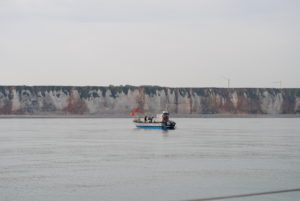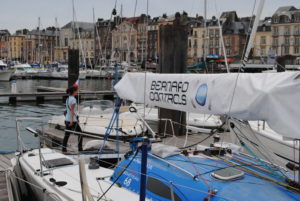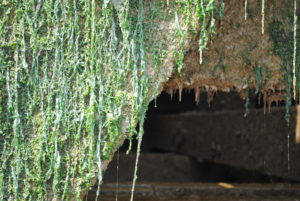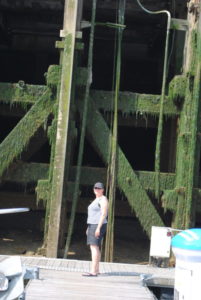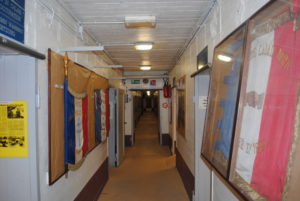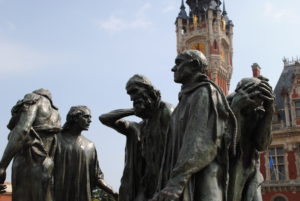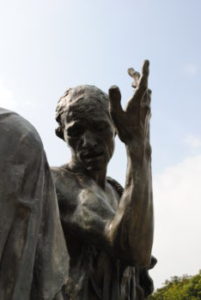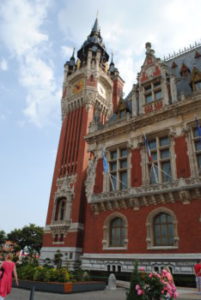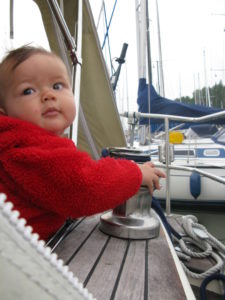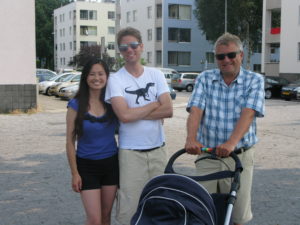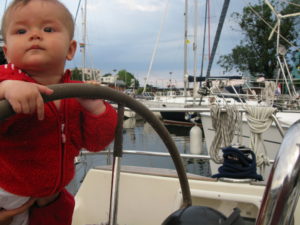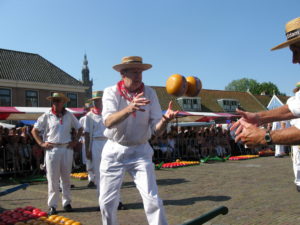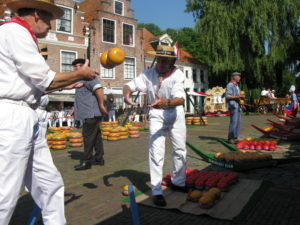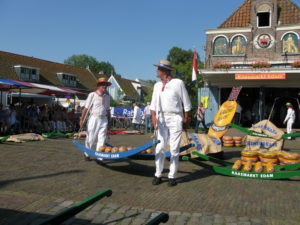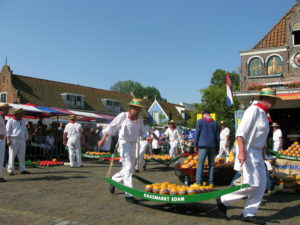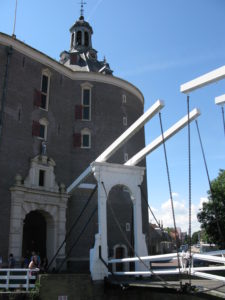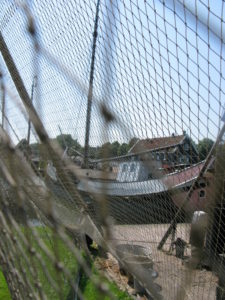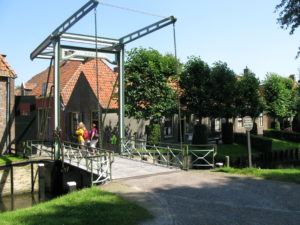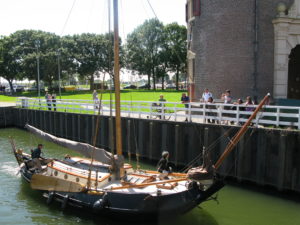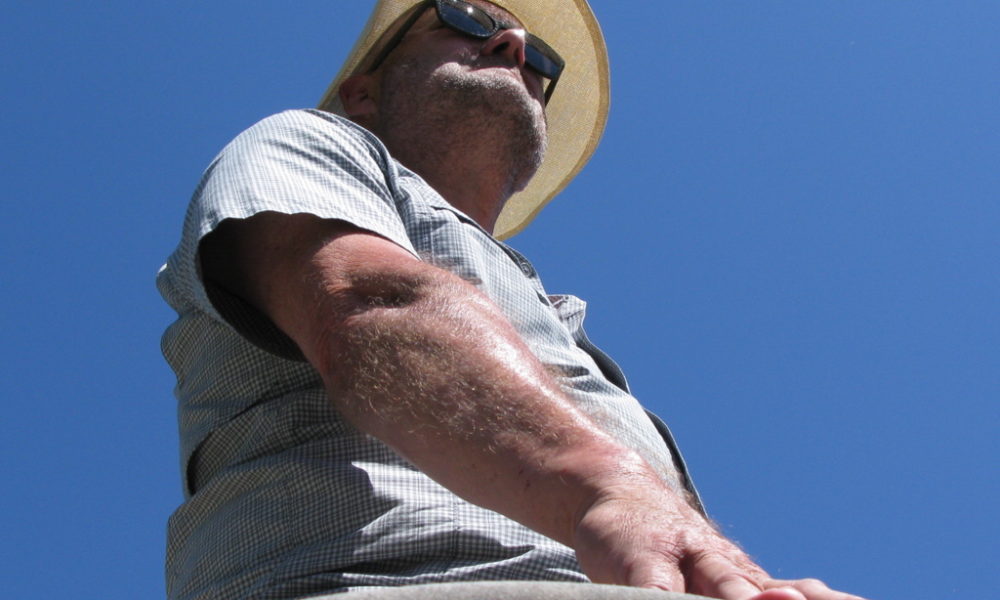
Yes. The autopilot is back on the team
50° 43′ 30.8316” N 1° 36′ 48.0024” E
July 16. – 2013
The autopilot is still confused and unable to hold a steady course for more than ten seconds. We read the manuals again and implement a series of experiments with modified settings.
Today the distance is longer and it is therefore important, that we can get help from the autopilot. We reduce response time for the autopilot. We adjust the rate of display between the autopilot and GPS. We reduce the range for course-deviations. We try virtually anything.
And yes!
We succeed!
By “aligning” the chart plotter’s rate view with the GPS system and by dimming the indicator for course-deviations we create a balance that works. It will be a fantastic trip.
We go into our normal division of labour, in which one person is on call for an hour, while the other is either reading or sleeping. These long distances are true vacations. Free time. Time where each person does exactly, what suits him or her. Kirsten reads Elisabeth Egholm’s latest novel. Per reads norwegian author Jo Nesbøs latest thriller “Police” and Dan Brown’s “Inferno.”
Along the way we eat breakfast, lunch, licorice and pistachios. Plenty of spring water.
Dieppe is a lovely town. It has churches, squares, pedestrian streets, scores of brasseries, cafes and restaurants – all collected in the neighbourhood around the port. It is intimate. It is authentic because the city had not been totally bombed away during WW2 but still has a number of imposing buildings around the harbour. We buy delicacies from the butcher, fruit shop and the baker, so the evening meal consist of quiche, baquette avec ceriale and cheeses.
Log-book: Sailed distance: 54 miles. Time: Departure 07.30 from Bolougne-sur-Mer. Arrival 14:00 in Dieppe. Crew: Kirsten and Per. Weather: Virtually no wind. Only for navigation engine.
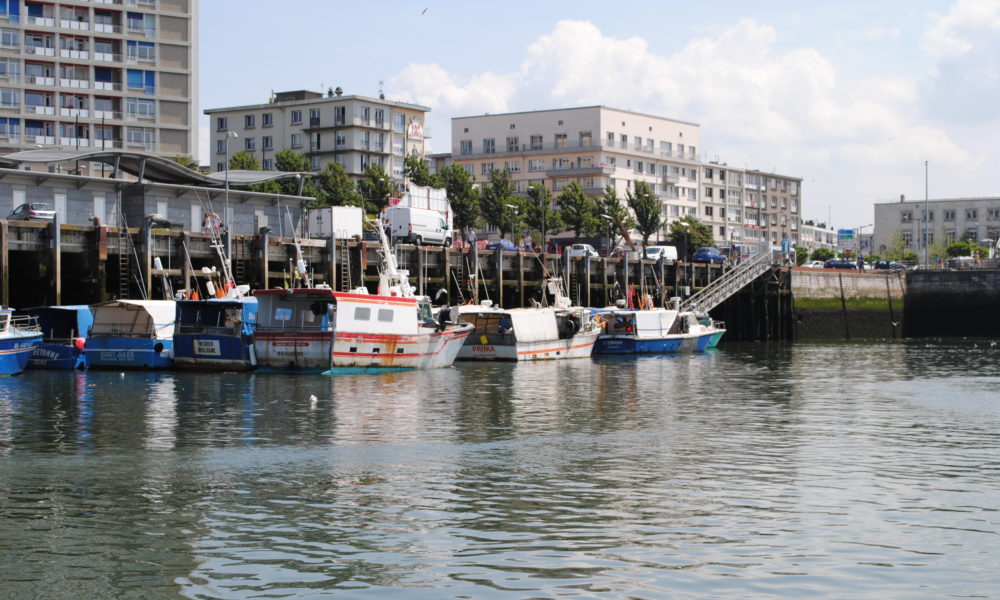
Noise and unrest. Fish stench and gulls. We are in Boulogne-sur-Mer
50° 57′ 4.644” N 1° 51′ 31.2696” E
July 15. – 2013
Damn, we are struggling with the autopilot and the chart plotter. We study the manual for the chart-plotter. We study even more intensely the manual for the autopilot. Manuals are read from front to rear. More boring prose does not exist in the world.
In an ugly cocktail of a sick autopilot and a sudden doubt of our calculations of how the tide will affect on “Ronja”, we decide to shorten the day’s range, and we call the port Boulogne-sur-Mer in stead of the initial target og the day, Dieppe. We fear that the current against us will be to strong, before we can reach Dieppe, and at the same time we would have to steer “Ronja” by hand for many hours.
Only a few days later, we know that the counter current is not that bad. We could have continued.
It is so amazing to enter these tidal ports. The piers are totally oversized. When visiting a port at low tide, you feel like a tiny speck in a vast world. On top of the tall, oversized piers you see small Frenchmen by the dozen fishing.
Boulogne-sur-Mer stinks of fish and echoes of seagulls. The marina is full of Dutch, it has a completely insane difference between low tide and high tide – something like seven meters – and when the first fishermen are getting ready for a new days work a little after midnight, they throw around for some hours with empty fish boxes. Not much room for a good night’s sleep. Hubbub. Fish stench and gulls. A somewhat overestimated stop on the trip.
We have, however, a really good lunch at a brasserie, where local French people flock during their lunch break. Mussels with french fries for Kirsten. Steak tartar, fried egg and friess for Per. Super.
The city is incomprehensible popular among boaters. Unfortunately, we are at the end of a ponton, and in the evening there are more sailors mooring on our side. A Dutchman and a Norwegian. The Norwegian becomes evidently bullied by some vociferous Dutchmen, who believes that his boat are bumping into them, and that he should pull a stern line all the way to the bridge, instead of just being moored to a Dutchman, which in turn is tied to our boat, Ronja. The Norwegian is cool. He is on vacation. He is not inclined to add to the vocal Dutchmen. We go with the Norwegian – for historical reasons – and notify him, that we agree, that the dutch are overreacting heavily.
In Boulogne-sur-Mer, we buy a handheld VHF to be used, when we take the mast down and no longer have the antenna to our regular VHF, and a water hose, because we have been told, that the tradition of the port offering water hoses to guests is not at all widespread in french ports.
Logbog: Sailed distance: 21 miles with one of Kirsten’s calculated ‘nudges’ in the back from the tide. Time: Departure 06.30 from Calais. Arrival 10:30 to Bourlogne-sur-mer. Crew: Kirsten and Per. Weather: Virtually no wind. Sailing for motor.
- The coast between Boulogne-sur-Mer and Dieppe
- The harbour in Boulogne-sur-Mer
- When the tide goes back it leaves interesting sights
- Impressive constructions in tidal harbour
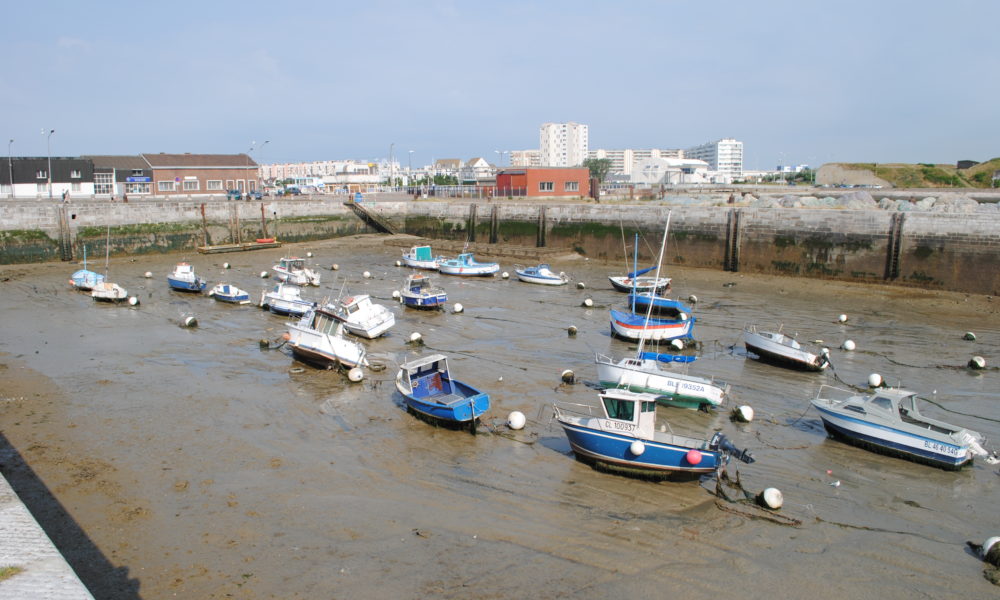
The boats in the neighbouring basin are on the bottom of a dried-up pool! Talk about tides
50° 57′ 4.645” N 1° 51′ 31.2696” E
July 14. – 2013
The sun shines. It will be a wonderful day. Calais is waiting.
After a few hours at the computer, where Per seeks to resolve a domestic problem at the newspaper, we explore the city. The boats in the neighbouring basin are located on the bottom of the dried-up pool! All the water is gone! Talk about tides.
We see the town hall, which was built in the English style. Calais was for many years in British hands. We rediscover the difference between a boulangerie, patisserie and boucherie. We visit a museum about World War II furnished in a huge German bunker built in the city’s most beautiful park. The bunker has 20 exhibition-rooms with pictures, props and newspaper clippings from the war. An old-fashioned museum concept yet thoughtful because of the subject and the horrific images.
Later, we are on the beach, where the French are getting ready to celebrate the fourteenth of July. It is teeming with bathers, with ice cream parlours, beach toys and promenading Frenchmen. It’s all to get in the holiday mood.
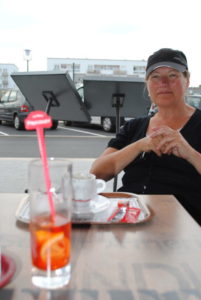
It’s still a little hard with the French. Kirsten’s first order in a cafe was for two coffees – “an espresso and an americano, thank you.” The waiter nods as a sign, that he understands the order and returns with an espresso and a bitter, pink drink called an americano.
During the day we decide to go to sea. We can come in and sail on the canals in time. If we continue along the English Channel and sail up the Seine, there are almost five hundred kilometres to Paris and only six locks. If we go into the channels here from Calais it is 450 km and 36 locks. We choose freedom of the sea. Even if we have to steer by hand all the way if we do not get the chart plotter repaired with its correspondence with the autopilot.
The plan is: Up at 6:30. Out through the port gate for 07:17. And after Kirsten’s increasingly authoritative calculations catch the southbound tidal current at 07:57.
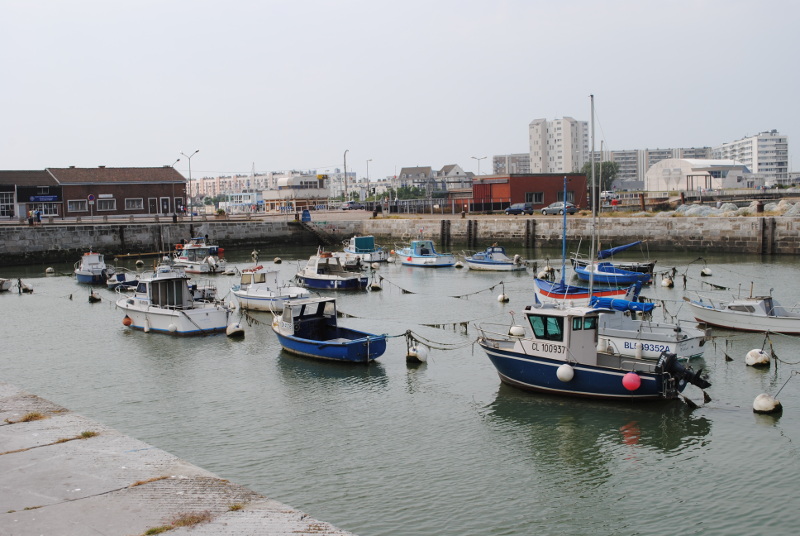
At high tide the boats are in the water. At low tide the same boats are lying at the bottom of the harbour
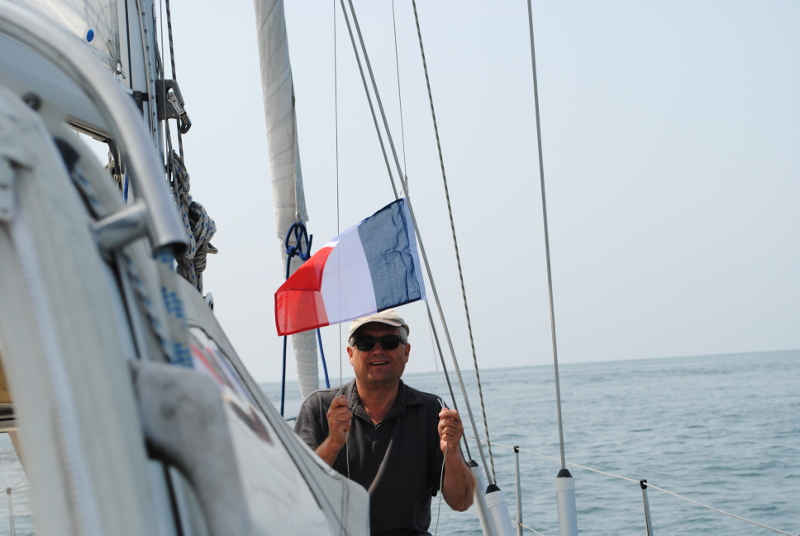
Vive la France! We are in Calais, France
51° 19′ 8.2092” N 3° 12′ 24.6636” E
July 13. – 2013
The harbour master in Zeebrugge had recommended discharge at low tide, minus two hours, plus 40 minutes to get out of the relatively large but rather dull port of Zeebrugge. Low tide on July 13 was 11.32. That made the departure 9:32 and then forty minutes to get out of the harbour. For safety’s sake we left at 8.30.
Having learned from yesterday, Kirsten set sail already inside the harbour. It did not, however, make a big difference. The English Channel was a mirror. Not a breath of wind.
Still, the day starts with an unpleasant surprise. The chart plotter goes out, and on the screen we see a revived icon of Ronja, revolved 240 degrees the wrong way on the map, which result in the fact that we cannot use the autopilot. Every time we try to do it believes that it is going completely the wrong way and therefore insists on turning the boat 240 degrees.
Sigh! Handheld rudder for eight hours. Not much to steer by. Just digital compass numbers. But the English Channel is nice. Certainly much more beautiful and more ingratiating than its reputation.
Then it’s “Vive La France!” We chug in with the giant ferries from England to the Calais port and immediately we meet a Frenchman who is driving his motorboat around with aggressive and theatrical gestures as he tries to capture a plastic dinghy. Already at the entrance to the port, we do sense a cultural shift.
Welcome to Calais. Tomorrow is Bastille Day. We find a place in the tidal protected waiting basin, and after less than one hour we are let into the inner harbour. We eat leftovers and are pleased to be in France.
Calais has so much to offer. It is an old British city. The City Hall has obvious references to Big Ben in London with a beautiful flower park spread before it. Amid the flowered park is an impressive work of Auguste Rodin, “the six burghers”. When the British had defeated the city in the 1300’s, the English king threatened to liquidate all its inhabitants. Six prominent citizens interceded. A very intense work.
Log-book: Sailed distance: 60 miles with the tide in the back for the first six hours and then tough counter flow a few hours down towards Calais. Time: Departure 09.30 from Zeebrugge. Arrival 17:00 to Calais where we should anchor at a bend in a basin until the bridge is opened into the marina basin. Crew: Kirsten and Per. Weather: North western wind maximum of 5 meters per second. Never has the channel been so flat.
- An oldfasioned museum in a bunker, however interesting
- Auguste Rodin, “The six burghers”.
- A very intense work of Rodin.
- The City Hall has obvious references to Big Ben in London
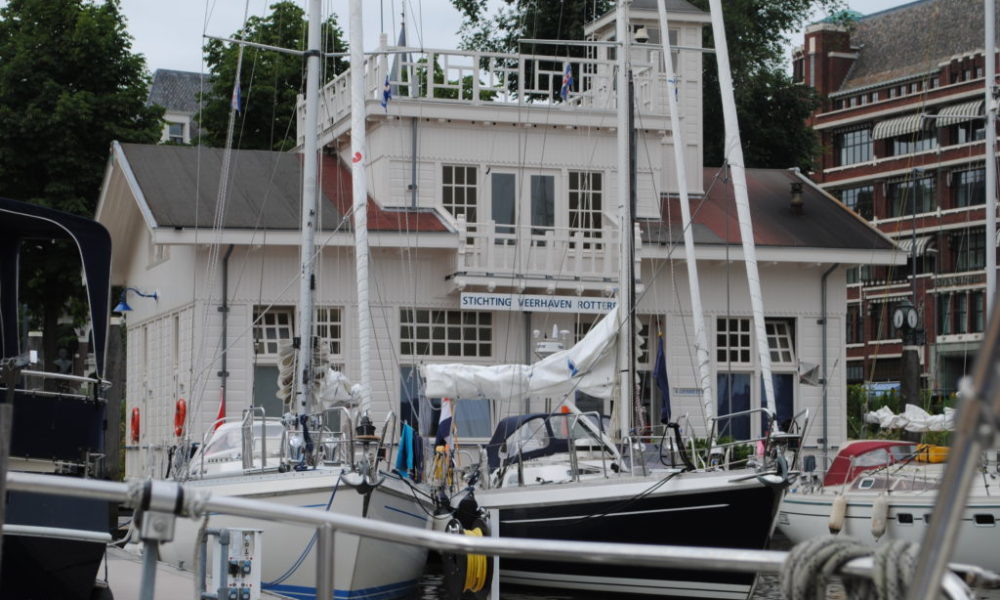
Rotterdam the largest port in the world? Likely
51° 54′ 33.7644” N 4° 29′ 57.264” E
12. juli 2013
The exit through the port of Rotterdam is indescribably exciting. Dynamic. Everything is incredibly large. The cranes, docks, tugs and warehouses. Kilometre after kilometre this huge port stretches itself. Through thirty unbroken kilometres side branch follows side branch, docks follows docks, crane follows crane. The largest port in the world? It is likely.
Cargo ships entering. Cargo ships on the way out. Huge. Small. Crawling into and out of the side channels. In the beginning only a few. During the early morning it becomes more. The port awakens. Rotterdam is in the process of getting the day into gear.
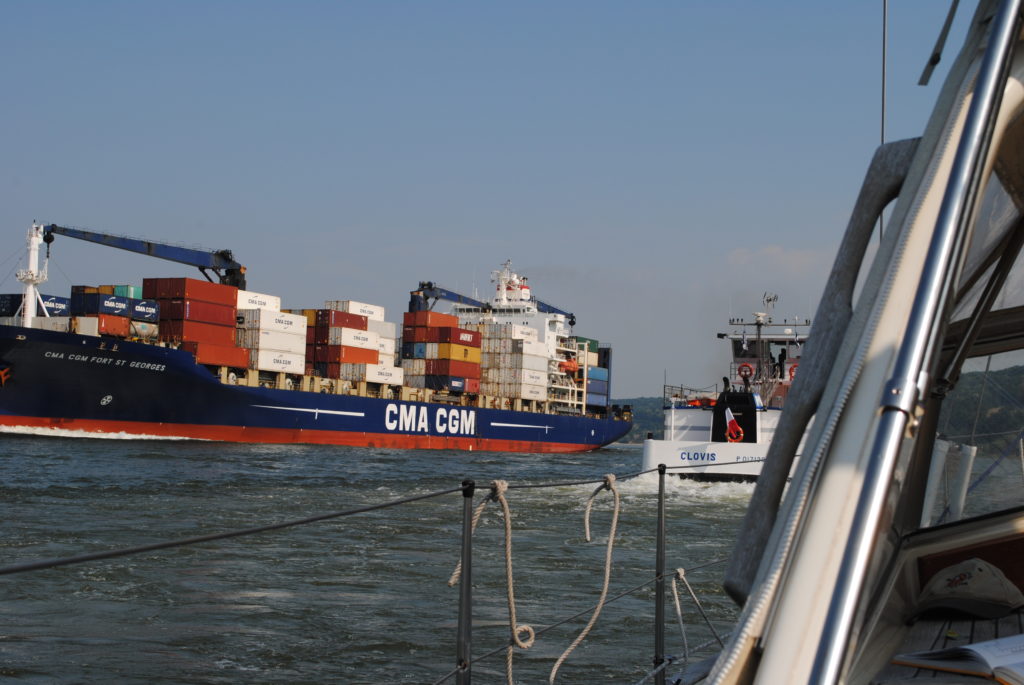
The vessels are sailing in columns on the Maas River to Rotterdam. The day is really waking up. Rotterdam moves up a notch.
We got up at 6:30 and said goodbye to Rotterdam before the clock hit seven. The harbour master in Stifting Verhagen Rotterdam – in combination with our own still a little hesitant calculations – told us that we get the most nudge in the back of the tide, if we start a little before high tide in Rotterdam and capture the southbound tide at the Maas River estuary off the Hoek van Holland. We do. The plan works.
Seven knots and later eight and a half knots, our speed through the English Channel, where we changed to go by sail in stead of motor, while we blissfully eat Kirsten’s homemade muffins with Dutch cheese and Italian sausage, sleeping half an hour alternately and otherwise enjoying a leisurely sail. High speed but completely under control because neither wind nor wave height is scary.
The Dutch have mastered the security of their inland waterway system. We change dutifully channel on VHF each time a sign on the country proclaims, that VHF channels now change to a new number, but we fail to call the station every time we come to a new VHF station, which had been recommended by the harbour master of Rotterdam City Marina. We sail gently. We are in control. Big brother in the Maas River control towers do not hear from us.
On the way out of the Maas exit we get called by a control tower.
“The yacht that just left the harbour entrance please report!”
“Ronja here!”
“Southbound or northbound?”
“Southbound”
“Have you seen the vessel just behind you?”
“Yes, we are intending to cross the traffic-line, just after they pass”
“Two more ships are coming in, please wait and keep to this channel.”
Later, we are contacted again by the control tower and asked to turn to the south, after the last of the two incoming vessels have passed. The vessels are sailing in columns on the deep-water route to the Maas River and Rotterdam. The day is really waking up. Rotterdam moves up a notch, while we have said farewell to a dutch adventure, that has lasted almost a year.
Log-book: Sailed distance: 75 nautical miles with the tide in the back of the Maas River and down to South Holland and Belgium. Time: Departure 6.50 from Rotterdam. In Zeebrugge, Belgium, 17.00. Crew: Kirsten and Per. Weather: North western wind maximum 7 meters per second. Wave height: 1 meter
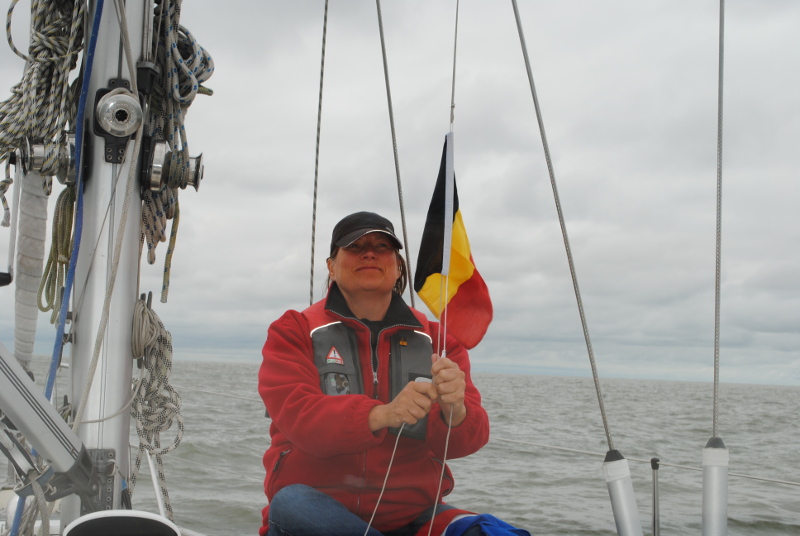
Goodbye Holland. Hello Belgium. Kirsten changes our guest-flag
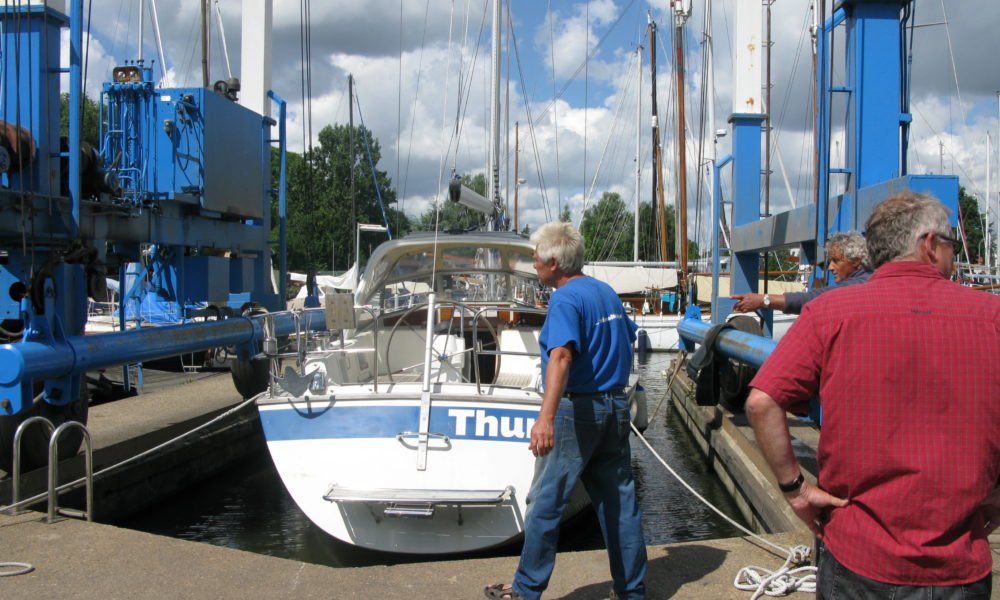
We are on our way again. With initial misunderstandings however
52° 23′ 1.6908” N 4° 56′ 6.8856” E
5.-11 juli 2013
We started to sail “Ronja” 11 months ago into Twellegea Nauticadam, Amsterdam’s suburb of Nieuwendam on the last day of July 2012 – she was the very first yacht, that was lifted for winter storage this year.
We visited her in spring 2013 to make her beautiful and ready for a new season. We hosed, we swept, we washed, we rubbed, we painted, we polished, we checked out of our hotel and slept on Ronja, and for a great many years, she has not beamed so beautifully ahead of a new season.
We had agreed with the port, that Ronja would be put in the water Friday, July 5 in the morning, where we would arrive by plane at night, just before midnight. It was even confirmed by an email, which said that Ronja was put into the production plan precisely on 5 July.
Yet Ronja was not in the water at all, when we in the evening arrived at Twellegea. The joy of anticipation was enormous. The agreement was that the keys would be in the bucket with the anchor chain. But alas. Ronja was still on her rack. 30 meters from the water. Nobody had launched her.
Damn! We go to the Harbour Office, which, amazingly, was staffed here close to midnight. The – in his own esteem – significant owner of Twellegea and four other marinas in Amsterdam was sitting in the office. Stoned. Hash? Wine? Whatever! He was out of reach. Kirsten scolded the glory from him.
“Now you’re not friendly,” pointed out the owner subtly. At the same time came the port’s female Head of office with her dog. Apparently they all live in the port on each their own boat.
“It’s my fault. I got a cancellation from another boat, and by mistake I cancelled your launch instead. Aw, I’m sorry. I really apologise,” she said.
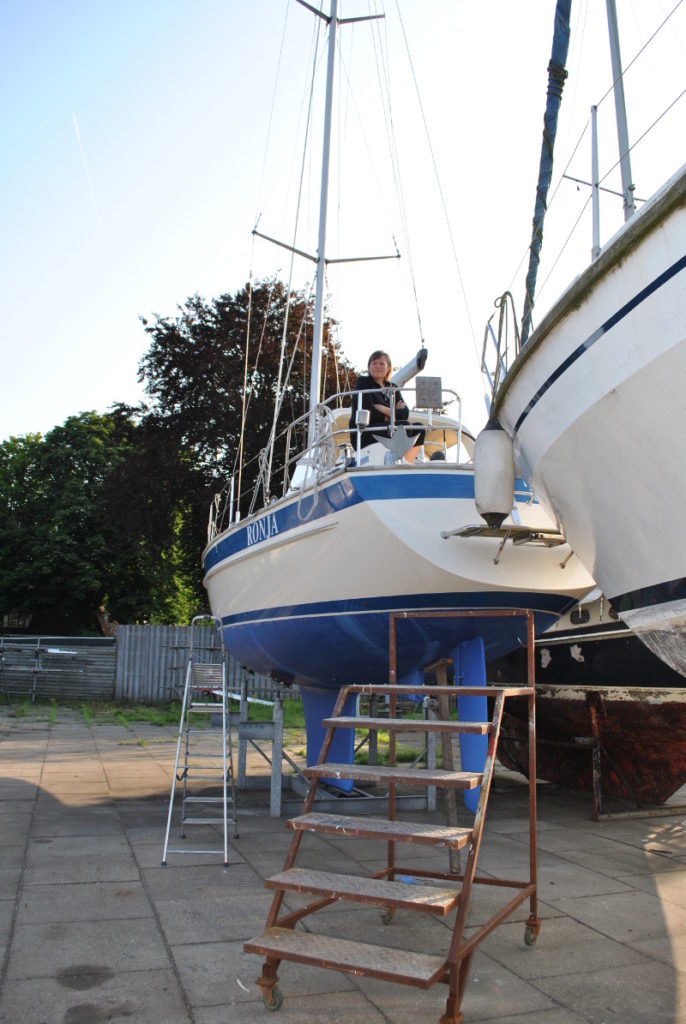
Skippers wife is angry. Ronja is not at all in the water as promised. She is still parked on the ground
Again we have to sleep on board Ronja, who unnaturally stands on four slender iron legs on the ground in a small suburb of Amsterdam.
The next day there is no end to all the things, that the port does for us, to make good their mistake. We are driven to the nearest supermarket in a Wrangler convertible. And we are picked up at the first call, when we later want to return with five shopping bags and a backpack full of groceries.
Later the harbour master calls and cannot promise to get us in the water. We insist and maintain the agreement, that we are going into the water. “We only have a limited number of vacation days,” we explain. “It’s ok. The fault is mine,” says the chief of office and she calls another, now retired but more experienced harbour master.
He is worth his weight in gold. He guides Ronja in the water gently and safely, and when we discover, that the engine is not running as it should, then he goes to war with the task and he works for three hours. He is airing. He empties the water. He injects diesel. He fetches tools and more tools. In the beginning he explains pedagogical, what he’s doing. Later he disappears into the task of solving the seemingly difficult task of revitalising Ronjas engine.
He succeeds. He’s an old aircraft mechanic, he tells us. “I have never met an engine that I could not handle,” he declares. Unrivalled dedicated efforts. We will of course pay the port for his effort but give him a 50 euro tip anyway. Wish we had ourselves his skill with a motor.
In the evening we dined at the Indonesian restaurant “puspita” which we also paid a visit before when we were down preparing Ronja in the spring. It cost 66 Euro for a wide and even exciting, varied meal with wine. That makes sense.
The next morning we left the Amsterdam Harbour. We said goodbye to the self-absorbed marina owner, his smart Wrangler convertible and his hazy, not very productive approach to life. “I’ve been sick for a couple of years,” he tells us. “My employees have not cared for the shop as they should.”
We sail out through the port of Amsterdam, and after a few miles we swing down a side channel and sail through the city of Haarlem. A really beautiful city, where the bridge on the bridge opens synchronously for us.
We are on the way. We are on the road again. We are heading towards new experiences. The big advantage of sailing is that every day brings us to new places, where we have never been before.
After spending a night in the town of Lisse, we sail on towards Gouda and Rotterdam. The Dutch understand how to live in natural intercourse with the water in the canals. The atmosphere is intimate. Balconies and terraces facing the river. Every man has his boat. Life is lived by the sea. How beautiful.
We stay in the city of Gouda. In the shade under the large hardwoods. Right in town. Four bridges and locks in. The same four bridges and locks out. Cumbersome. But it should be tested.
Bonus info: Gouda cheese is suitable for Pasta Bolognese, when you have forgotten to buy parmesan. Preferably, however, Gouda cheese in the dry and strong version.
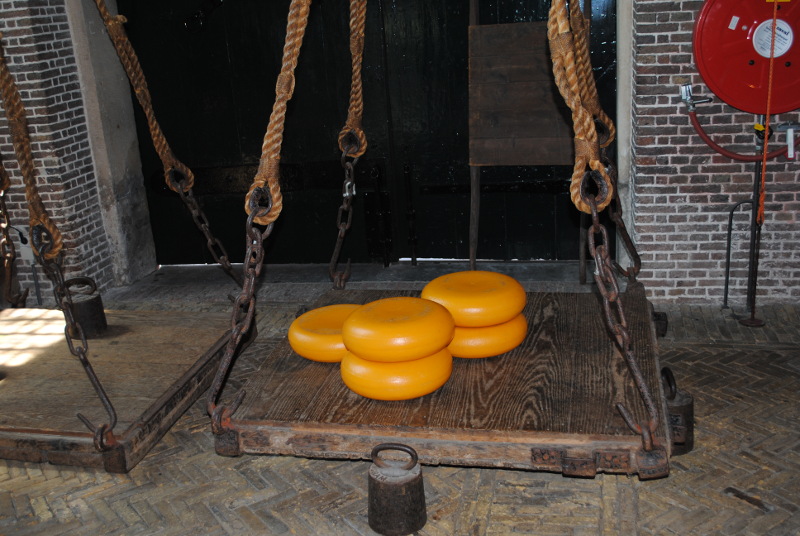
The city of Gouda gets a lot out of their status as homecity for the Gouda-cheese. Certain weekdays they even have a cheese-show for tourists
From Gouda we sail to Rotterdam and we dock for a start in City Marina Rotterdam. Excellent facilities. Nice location for walking and jogging in Rotterdam, where we visit an impressive museum of modern art, at a not so good maritime museum. It seems they have to maritime museums, vi just chose the wrong one.
The last night in Rotterdam we change to another harbour, Stifting Verhagen Rotterdam, only half a mile from City Marina. We do not want to be dependent on the rare opening-hours through the enormous Erasmus Bridge. In the new harbour we have rijstaffel again at the restaurant ”dewi sri”, a more upscale version of an indonesian restaurant than in Nieuwendam. Doubble price, 119 Euro, and only accurate the same quality.
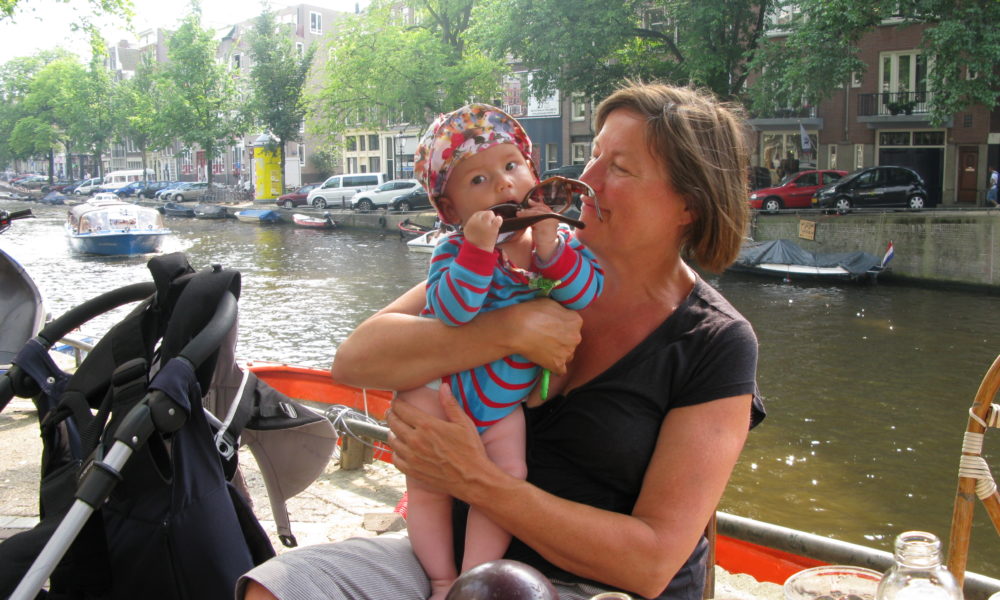
Family days in the heart of Amsterdam
52° 22′ 55.903” N 4° 54′ 22.499” E
25th-30th July, 2012
We find a berth right in the heart of Amsterdam. In Sixhaven – three minute free ferry ride from central railway station.
We explore the city immediately. Watching Van Gogh Museum and walk the city along the canals and through canabis-scented alleyways. It is agreed that Lasse, Tianling and Nellie, will arrive in Amsterdam, where they live with us on the boat through July 29.
Lovely family days in versatile Amsterdam. When Lasse, Tianling and Nellie returns to Denmark, we find a good winterharbour for Ronja in a suburb to Amsterdam. This will be Ronjas home the next 11 months.
- Nellie klar ved skøderne
- Tianling, Lasse and Per i Amsterdam
- Det kræver en tidlig start at blive en forrygende sømand
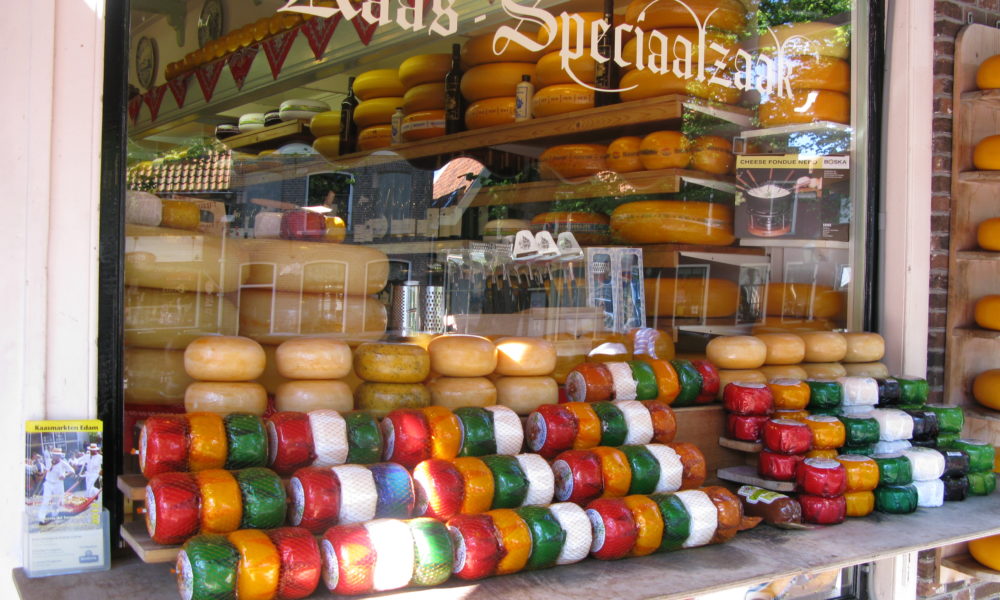
Theater around a cheese
52° 30′ 45.492” N 5° 2′ 57.054” E
July 24, 2012
A Raymarine expert comes in the morning and repairs our chartplotter. “Software,” he explains. The plotter is from 2006 and it short, we have tried to install is from 2012. It requires an update. Ten minutes to 70 €. Clearly worth the money.
Then we will sail to Edam. Once a picturesque canal. We are now in the Markermeer, which is separate from Ijselmeer with a dike and a lock.
We decide to sit Edam city another visit Wednesday afternoon to attend the city’s major attraction: The cheese market. Very funny, really. Very colorful. But somewhat inflated compared to actual market content. Amatørteater around a cheese.
Logbook: Departure 11:30. Destination: Edam. Arrival 14:00.
- What a spectacular show, cheese are..
- ..thrown man to man, elegantly..
- ..carried around the square..
- ..and probably it is all about selling cheese from Edam
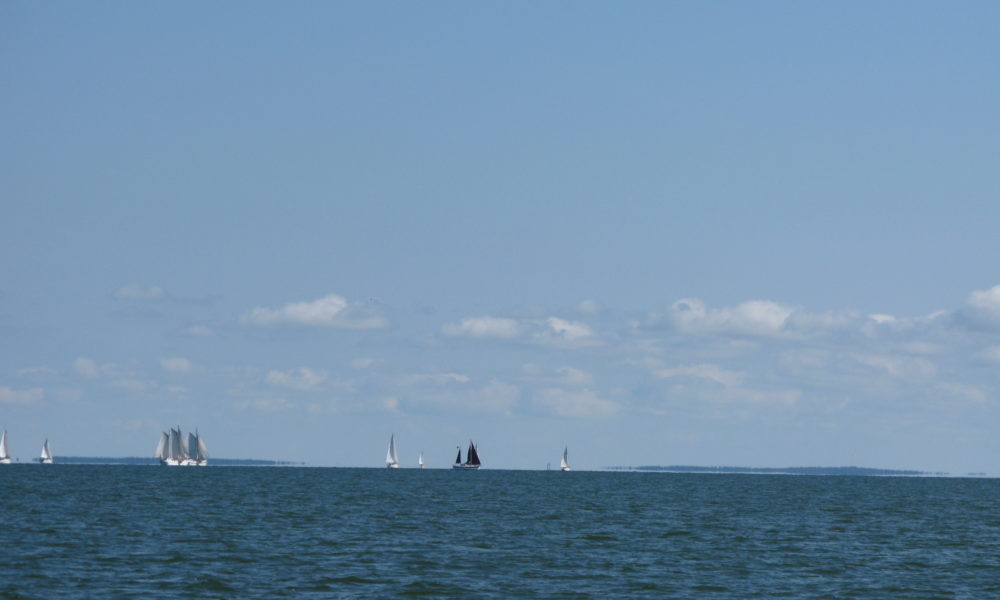
Enkhuizen – is a sailors mecca. Boats, boats and boats
52° 42′ 15.0948” N 5° 18′ 1.0188” E
22 and July 23, 2012
They are crazy, the Dutchmen! The bakers are closed on Sundays and on weekdays they open frequently as other stores.
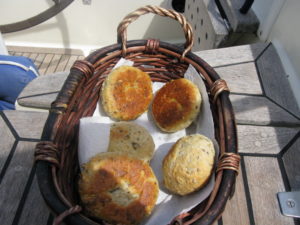
While Kirsten turns dough up to own morning buns, we head towards Enkhuizen. It will be a perfect day for sailing. The wind is in front of the cross. Ijselmeer is smooth, almost uniformly deep (read: low). All the time a meter or two below the keel.
The sun shines. Soon we thing, that we can see Enkhuizen. “Look, they have cliffs,” says Kirsten. It turns out to be a huge forest of masts. Enkhuizen has six to seven ports, the port we call, has room for 700 boats. Never have we seen so many sails on the water as in front of Enkhuizen. The city has a reputation as being a sailors mecca. After weeks of rain all sailors are going to the see to have som air in their sails – like cows when they are let out of the barn on the first day of spring.
We take an extra day in Enkhuizen, which starts with a jogging tour around the city walls. It is a charming city. Perhaps the most beautiful of the canal towns we have seen so far.
We also visit an open air museum “Zuiderzee Museum”, which is a really good museum, very active, interesting.
Log book: Departure 8.30. Destination: Enkhuizen, Arrival 11:00.
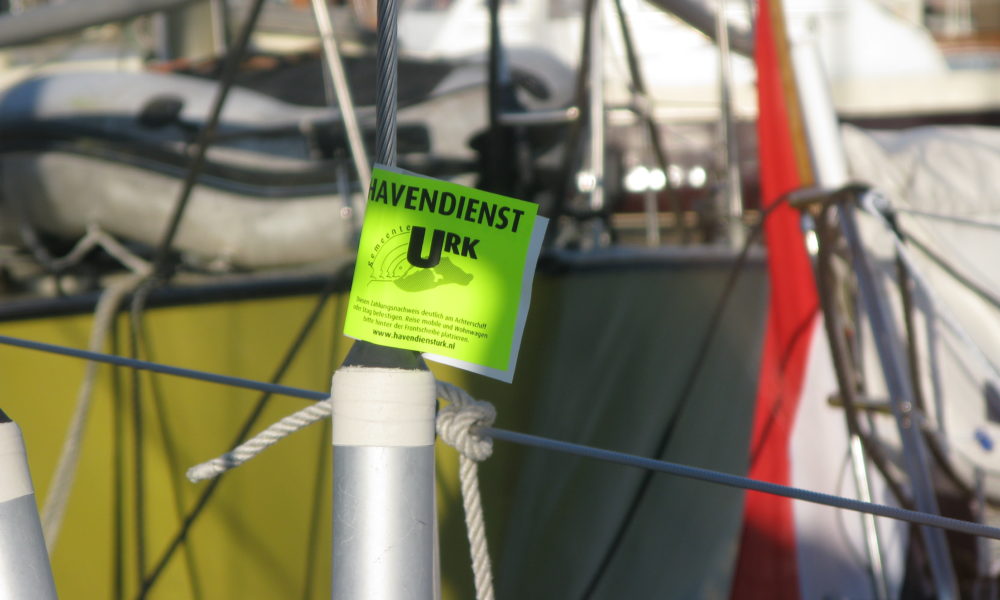
Urk is ok. Sailing under full sail on the Ijsselmeer
52° 39′ 34.3728” N 5° 35′ 48.8904” E
July 21, 2013
We take a morning run of 6 km. along the water and underway we check the two lock options to get out in Ijselmeer.
The weather is fine. We are considering a day of rest, but we decide anyway to sail. We have spotted a store, where they may have Raymarine charts. The store is on the way out to Ijselmeer.
Since Delfzijl we have not had life in the chartplotter. And now a brand new chart bought at a store in Lemmer does not work either. What is happening? Back to the store again. We want our money back: 249 Euro.
We really wanted to go to Enkhuizen on the opposite side of Ijselmeer, but the wind would rather lead us to Urk on the same side as Lemmer. We are in need of a good sailing under full sail, so we let the wind determine. And the wind point us to Urk.
